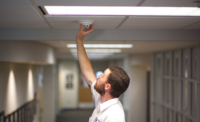Between the 3G sunset and the disappearance of plain old telephone service (POTS) lines, it has never been a more interesting — and maybe hair-pulling — time to work in the fire alarm industry. If technology in the security industry is always changing, consider the fire alarm industry a line of work where one misstep can mean life or death.
“POTS analog alarm transmission is outdated, unreliable and unsustainable, particularly with the rise of 5G technology,” says John Beckwith, senior director of offering management, fire and life safety systems, Honeywell Building Technologies, Atlanta. “Support and service are being discontinued while monthly costs continue to increase. This can leave sites vulnerable without the ability to transmit fire alarm signals to the central station. Localized panels are losing the networks that they used to push signals to outside entities, and, again, the signals will not be sent.”
Which is to say: if you’re still relying on POTS, it’s time to make the switch.
“People are not hooking up fire alarms up to phone lines any longer,” says Tom Karl, vice president of corporate sales, NAPCO Security Technologies, Amityville, N.Y. “Everyone is being connected to a cellular communicator of some sort.”
Fire alarm control panels are just one piece of technology in the industry that’s finally catching up to the 21st Century. And, it’s never been more important for them to be up to date, considering their purpose.
“The use of cellular devices and other alternatives — e.g., the internet — to traditional POTS continues to increase, to the point that these ‘alternatives’ are becoming the mainstream choice rather than the occasional exception,” says Daniel Rosales, senior director of technical services, Telguard, Atlanta.
From cellular communicators to going wireless, here’s what you should know about fire alarm control panels (FACPs).

NFPA has permitted communication technologies other than POTS, including radio, cellular, and IP-based communication methods. // IMAGE COURTESY OF HOCHIKI
Trends in Fire Alarm Control Panels
The HVAC and lighting industries are already incorporating IP-based devices into their installations. So, it’s no surprise that cellular communication is becoming a standard on existing and new fire alarm installations. An IP-based system can easily connect to mobile devices and interact with building systems more seamlessly, including access control, security, CCTV and others, according to Bill Denney, technical product manager, Hochiki America Corporation, Buena Park, Calif.
“This integration may open the way for more intelligent notification of life-threatening events, more detailed information available to firefighters such as if a room is occupied or not, and if doors and other openings in a room are closed or open,” he says.
IP-connected systems will need to be protected from cyber-attacks, which have become a large topic of discussion in the security industry. The 2022 Edition of NFPA 72 has recognized this concern with the addition of chapter 11, Cybersecurity.
“There will likely be more information added to this chapter as the implementation of IP-connected life-safety systems increases,” Denney predicts.
IP connections can add more services and features that enhance the level of interaction for integrators, according to Rosales of Telguard.
“This would not be possible using standard POTS connections, which is why alternative communication paths like cellular and internet for alarm communicators are becoming more and more widely used,” he says.
With the 3G and POTS sunsets, Beckwith says 4 and 5G wireless connections are becoming the new standard.
“These communicators are generally simpler to install, more reliable than the 3G or POTS lines they replace and capable of connecting to multiple carrier networks, especially if they are dual SIM like the Honeywell Connected Life Safety Services (CLSS) Pathway,” he says, “Additionally, POTS lines have become more expensive to maintain, so replacing legacy technology can often be funded by cost savings.”
Beckwith says there is growing support for making fire alarm system data available for use by building owners, facility managers, installers, maintenance service contractors and authorities having jurisdiction (AHJs) throughout the lifecycle of the fire system.
“Given their experience in their personal and professional lives, these key stakeholders are beginning to expect their fire system to have a mobile app to provide status updates and access to key documents like inspection reports,” he says. “Gateways, and ‘smart’ alarm communicators enable this capability by connecting the FACP to external services intended for these users such as Honeywell CLSS.”

NAPCO’s Starlink LTE cellular communicators are designed to upgrade any manufacturer’s old communications methods, including sunsetting 3G/CDMA radios, leased line/POTS landlines or mesh radios. // IMAGE COURTESY OF NAPCO
Limitations & Opportunities
The limitations of FACPs are often their legacy network connections. Building owners and facility managers are not always aware of these changes, and when the panels’ connections are not updated, they become ineffective. Fire contractors must proactively approach their subscribers and make them aware of the POTS sunset. If they do not, the copper POTS line will fail, and the carrier will refuse to repair them, resulting in an emergency service call and perhaps a fire watch. This means that a competitor can approach your subscriber and make them aware of a switchover to cellular and offer significant savings on their current monthly bill. For multiple locations, the savings grow exponentially, which is money lost for the fire contractor.
“A fire contractor can easily lose valuable multi-location subscribers if they are not careful,” Karl says. “It is critical to maintain communications with your customers and offer to switch them to cellular as soon as you can. That subscriber is a sitting duck for the competition. We try to give our customers all the tools they need to demonstrate in an indisputable way what those savings can be.”
FACPs and fire systems can also be time consuming to install and maintain, which has become a large problem as labor has become scarce and COVID-19 restrictions make building access a challenge, according to Beckwith.
“Additionally, there is potential for error in several steps in the process, such as setting up central station reporting,” he says. “Improvements in configuration tools and connectivity can automate key processes, reducing errors and the time it takes to commission, troubleshoot or inspect a fire system. Remote diagnostics and digitized maintenance technologies limit site visits and time on site during maintenance and test and inspect.”
According to Denney, FACPs will do what they’re designed to do. However, there are ways to improve the performance of the systems, including utilizing performance-based communications for monitoring and producing better-performing fire detectors, as seen in the 7th edition of UL 268.
“As technology advances and improves, it is certain that some of this will trickle down to the fire alarm world too,” Denney says. “Life safety serves a valuable and important function in our daily lives, and it is only right that fire alarm systems benefit from advances in technology.”
Traditionally, FACP remote interactions have been limited by central station communications: the only way to get panel information back to the integrator was through the central station. This means that the vast majority of systems have limitations put on by the POTS protocols they can communicate in, Rosales explains.
“Industry advances are looking at other ways to upload information to cloud systems that would be more easily accessible not only to integrators, but end users, and other entities as well,” he says.

Hochiki’s primary fire alarm control panel is L@titude, an analog-addressable system. It includes features for interfacing and control of other building systems, such as input/output logic configuration and BMS integration using the company’s Vizulinx interface module. // IMAGE COURTESY OF HOCHIKI
The Outlook Ahead
The limitations of FACPs means there are many possibilities for the future. According to Beckwith of Honeywell, the future of fire alarm control panels is all about “scalability, connectivity and simplicity,” pointing to Honeywell’s own goals.
“The fire panels of the future are going to be modular and scalable to allow the system to be easily expanded and grow with a building,” he says. “We’re incorporating the power of predictive maintenance to the fire system and providing better reporting for mandated inspection and maintenance.”
AES Corp., Peabody, Mass., has partnered with Potter to integrate its mesh technology into one of their fire panels and is working with other manufacturers to continue these types of integrations, says Laura Wall, vice president of product. “Installation of AES technology is becoming easier as it integrates its product with other fire alarm manufacturers,” she adds.
Another development, Denney says, is automated testing of fire alarm systems and devices.
“NFPA 72 has recognized automated testing for a long time, yet it would seem that this is not widely implemented as of yet,” he says. “Automated testing would save time and cost, while increasing the reliability of the system and devices as troubles would be recognized and signaled quickly.”
Rosales of Telguard predicts that using FACPs to create more RMR by incorporating remote monitoring for a higher level of interaction with the integrator and end user — using both cellular and internet-based technologies — is set to come.
“Today’s world of fire and life safety no longer relies on a single revenue source for fire integrators,” he says. “It now brings about multiple sources of RMR, which include cellular service and enhanced features and services.”
Karl says solutions like NAPCO’s fire panel with cellular communicator are having a big impact on security dealer’s and integrator’s ability to install and convert from POTS to cellular, a trend that is likely to continue.
“We took our fire alarm panel and built a cellular communicator into it … and we can’t make them fast enough,” he says. “Building the communication technology into the FACP is a huge time and labor savings for the installer and support personnel. There are fewer parts to order and stock on the truck and it’s a big labor saver by eliminating the need to mount the communicator, provide power, etc.
“By completely eliminating the labor of installing the communicator, you can save a great deal of the hours allocated for the complete installation, in some cases up to 50 percent.”









